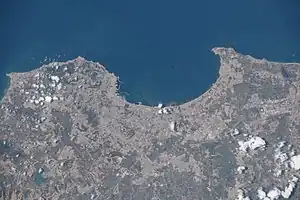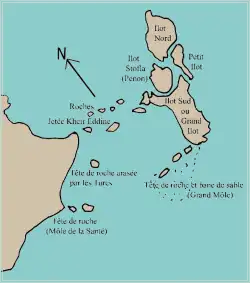
Peñón of Algiers (Spanish: Peñón de Argel, Arabic: حصن الصخرة, romanized: ḥiṣn aṣ-ṣaḵra) was a small islet off the coast of Algiers, fortified by the Kingdom of Spain during the 16th century. The islet was connected to the African continent to form a seawall and the harbour of Algiers.
History

In 1510 the Spaniards settled on a small island, the Peñón, north of Algiers (in modern Algeria). They forced Sālim al-Tūmī (Selim-bin-Teumi) to observe the terms of a treaty with Spain, namely, to accept a Spanish presence and to pay tribute.[1][2] Fortifications were built on the islet, and a garrison of 200 men was established.[2] Sālim al-Tūmī had to go to Spain to take an oath of obedience to Ferdinand of Aragon.[2]
The islet was captured in 1529 by Hayreddin Barbarossa during the Capture of Algiers. Barbarossa dismantled the fortifications, ending the Spanish presence in the area.
References
- ↑ International Dictionary of Historic Places: Middle East and Africa. Trudy Ring. p. 54.
- 1 2 3 E.J. Brill's first encyclopaedia of Islam, 1913-1936 by Martijn Theodoor Houtsma. p. 258
36°46′N 3°08′E / 36.767°N 3.133°E